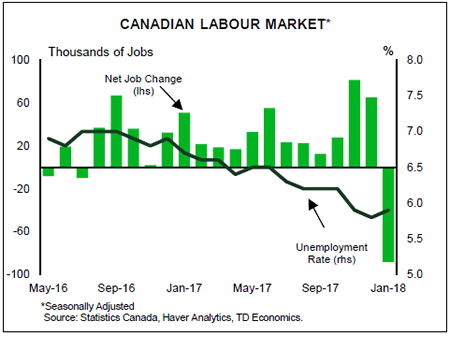U.S. Highlights
- Markets sold off sharply this week, following a somewhat hawkish assessment of the U.S. economy from the Fed’s new chair Jerome Powell and the announcement of steep tariffs on steel and alumimium imports by Donald Trump.
- Despite the market reaction to Powell’s comments, there was not much in the data this week to indicate that the economy is overheating. Both headline and core PCE inflation remained unchanged in January, coming in at 1.7% y/y and 1.5% y/y, respectively. Real consumer spending fell by 0.1% on the month. Vehicle sales also weakened in February.
- Both consumption and GDP will start the year on a softer footing but weakness is expected to be short-lived. Tax cuts and tightening labor market will support consumer spending and above-trend growth over the remainder of 2018.
Canadian Highlights
- The marquee event this week was the 2018-19 federal budget, which despite an array of new spending measures, contained little in the way of policies intended to address Canada’s newly disadvantaged tax position versus the U.S.
- Real GDP hit 1.7% (annualized) in the fourth quarter, below the Bank of Canada’s forecast. The monthly figure edged modestly higher in December, up 0.1%, signaling diminished momentum to end the year and a soft hand-off into 2018.
- A softer-than-expected GDP print coupled with a maintenance-type budget provides the Bank room to be patient on the rate hike front, but data-dependency remains in place.
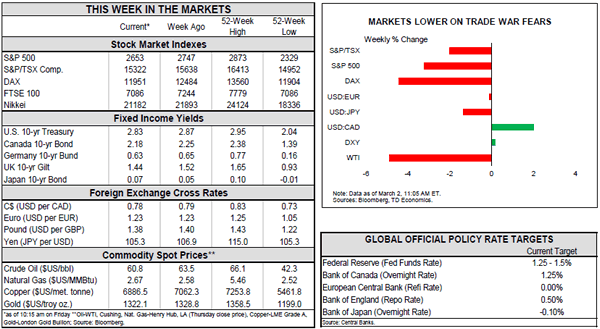
U.S. – Fears of Trade War Rattle Financial Markets
This was a busy and difficult week for financial markets. Economic data releases were overshadowed by the much anticipated first Congressional testimony by the new Federal Reserve chair Jerome Powell and trade tariff announcement from the White House.
In his speech on Tuesday, Mr. Powell struck an upbeat tone on the U.S. economy and inflation, saying that his "outlook for the economy has strengthened since December." He also highlighted potential upside risks to growth and inflation stemming from fiscal policy and the improved global economic backdrop. Without stating the exact number of rate hikes expected this year, Powell seems to have opened the door to a faster rate of normalization as long as the economic data cooperates. Markets were quick to interpret his comments as hawkish, with equities selling off and bond yields rising. New York Federal Reserve president Bill Dudley added more fuel to the fire by saying that four rate hikes by the Federal Reserve this year would still constitute a "gradual" pace of tightening.
Market losses extended further on Thursday on fears of trade wars following Donald Trump’s announcement of a 25% import tariff on steel and 10% on aluminum. While nothing has been signed yet, should these tariffs be introduced, they will lead to higher input prices for many manufacturing and construction industries which rely heavily on steel and aluminum inputs and ultimately result in higher prices for U.S. consumers, thus posing an upside risk to the Fed’s inflation outlook. The Fed may look through a one-time change in prices as a result of tariffs, but will be cautious on the impact on inflation expectations and potential economic growth – trade wars are not typically good for productivity growth.
Still, for the time being there is not much in the incoming data to indicate that the economy is overheating. Inflation-wise, both headline and core PCE inflation remained unchanged in January, coming in at 1.7% y/y and 1.5% y/y, respectively. Real consumer spending fell by 0.1% on the month, despite strong gains in real disposable income (+0.6% m/m) on the back of lower taxes. Indicators of housing activity were also soft. Coming on the heels of a decline in existing homes, January sales of new homes and the forward looking pending sales of existing homes also weakened. Ditto for auto sales, which edged down to 17.0 million units in February from 17.1 million in January. All in all, similar to the prior years, both consumption and GDP will start the year on a softer footing.
That being said, the slowdown will likely be short-lived. Some of the weakness in consumption is likely a pullback from the hurricane-induced ramp up at the end of 2017, and some due to "residual seasonality," which has become apparent in recent years. Barring unexpected developments trade-side, tax cuts and a tightening labor market will prop up household income this year, supporting robust consumer spending and above-trend growth over the remainder of 2018.
All in all, the latest data does not change the calculus for the Fed with three rate hikes expected this year, however, the central bank will certainly need to keep a close watch of the economy, given rapidly evolving U.S. public policy.
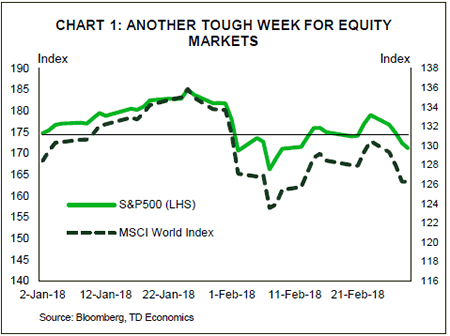
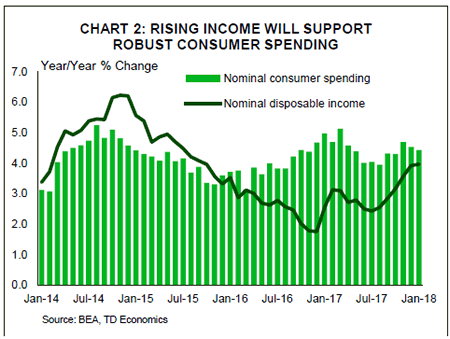
Canada – Placeholder Federal Budget Caps Busy Week
It was a fairly busy week for Canadian markets, with several key economic reports and a budget to boot. Sentiment has soured during the week, with the TSX lower in recent days, partly on the back of statements by President Trump indicating that he planned to put punitive tariffs on aluminum and steel imports, sparking fears of a trade war. Softer oil prices amid a larger-than-expected inventory build south of the border also weighed on bourses, as did the inaugural testimony to Congress by the newly-minted U.S. Federal Reserve Chair Powell, who struck a bullish tone, signaling that the pace of hikes may be faster than expected. Powell’s speech also sent global bond yields higher though the back-up in Canadian bond yields proved temporary, as weak domestic data weighed on them.
Arguably, the marquee event on the economic calendar this week was the release of the federal budget for the fiscal year 2018-19. The federal government plans to use an improved fiscal starting position to fund an array of new initiatives. This should inject some modest near-term stimulus into the Canadian economy. However, the government is banking on the notion that on-going economic growth coupled with slower program spending will keep the federal deficit at a manageable 1% of GDP and the leave the debt-to-GDP profile on downward track (Chart 1). Despite some $20 billion in new spending initiatives announced, in many ways the budget felt like a placeholder. Sweeping U.S. tax reforms have eroded Canada’s competitiveness on the global stage, leading to calls for a response from the government. However, the budget contained little in the way of measures to address Canada’s disadvantaged position, opting for monitoring instead. At this point, it appears that the government is keeping its powder dry ahead of next year’s pre-election budget.
While the budget took centre-stage early on, the release of the Q4 GDP figures capped off the week. GDP growth hit 1.7% (annualized) in the fourth quarter, averaging a robust 3.0% during 2017 overall. The quarterly pace represented a slight strengthening from Q3, but was below the Bank of Canada’s estimate of 2.5%. Net trade was slightly less of a drag on growth, with exports improving in part due to higher automotive production – previously depressed on maintenance shutdowns and a labour disruption. Consumer spending slowed sharply but nonetheless remained a positive contributor to growth, while residential investment benefitted from higher home sales ahead of the implementation of the B20 guidelines (Chart 2). On a monthly basis, December’s gain was a modest 0.1%, as growth was restrained by weak construction, manufacturing, wholesale and retail activity.
All told, economic growth has clearly downshifted from the solid pace observed in the first half of 2017 while December’s relatively modest print points to rather soft momentum heading into 2018. This will likely motivate a downgrade to the Bank of Canada’s forecast for growth, and affords more patience on the rate hike front.
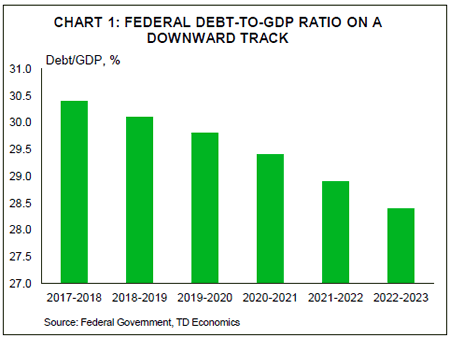
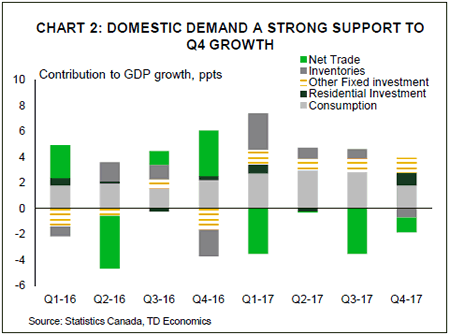
U.S.: Upcoming Key Economic Releases
U.S. Employment – February
Release Date: March 9, 2018
Previous Result: 200k, unemployment rate: 4.1%
TD Forecast: 175k, unemployment rate: 4.1%
Consensus: 203k, unemployment rate: 4.0%
We expect nonfarm payrolls to advance by a respectable 175k in February, recording a pace slightly below the 6-month average trend. We expect the unemployment rate to stabilize at 4.1% though unrounded figures should show a decline. All eyes are on average hourly earnings following the January upside surprise that left wage growth tracking at 2.9% y/y. With the 12th of the month landing on a Monday, calendar effects are favorable in February for a strong 0.3% m/m print. However, we see scope for disappointment as monthly readings have a high tendency to mean revert, while any wage increases in response to tax reform are likely insignificant in the aggregate. We expect a 0.2% m/m increase, leaving the y/y pace lower at 2.7% vs 2.9%. Downward revisions cannot be excluded as well, which point to further downside risk to the y/y figure.
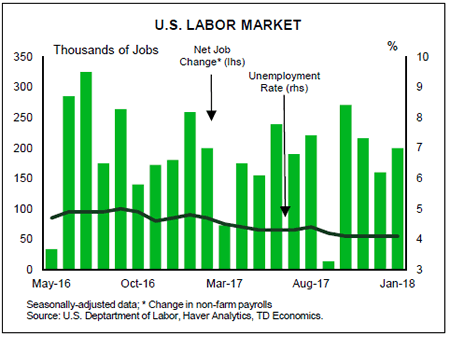
Canada: Upcoming Key Economic Releases
Canadian International Trade – January
Release Date: March 7, 2018
Previous Result: -$3.2bn
TD Forecast: -$3.0bn
Consensus: N/A
TD looks for the merchandise trade deficit to narrow to $3.0bn in January on higher export and import activity. Energy will provide the driving force behind export growth though we also see upside risks to non-energy exports on a surge in motor vehicle production, which continues to normalize after transitory disruptions. Imports should see a more tepid pace of growth on the slowdown in consumer spending, though aircraft imports should rebound on Boeing deliveries.
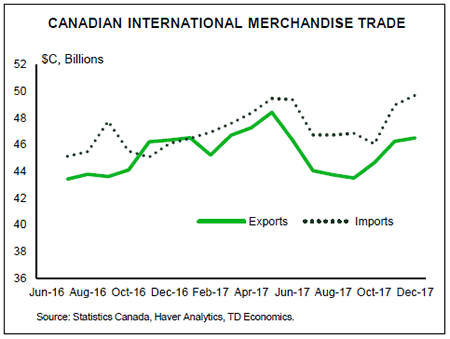
Canadian Employment – January
Release Date: March 9, 2018
Previous Result: -88k, unemployment rate: 5.9%
TD Forecast: 2k, unemployment rate: 5.9%
Consensus: N/A
We expect job creation to print at a subdued 2k in February after the January cold shower of -88k. While outsized LFS prints tend to reverse the following month, we think the dismal January report is mostly explained by the impact of the Ontario minimum wage hike and unsustainable gains over the prior three months as LFS outperformed the less timely SEPH measure by roughly 130k in Q4, the largest gap on record. Moreover, we expect the Ontario minimum wage hike to continue weighing on the regional labour market and we could see further job losses in February, concentrated in low-wage industries (accommodation and food services). We do see scope for a reversal in the full/part time split at the national level, which would add a downbeat tone to the headline print. We expect a small rebound in labour force participation after the rate fell 0.3pp in January, though the unemployment rate should hold at 5.9% from an unrounded 5.85% the prior month. Finally, wage growth for permanent employees is expected to slip to 3.0% from 3.3% on base effects and moderating underlying wage pressures.
